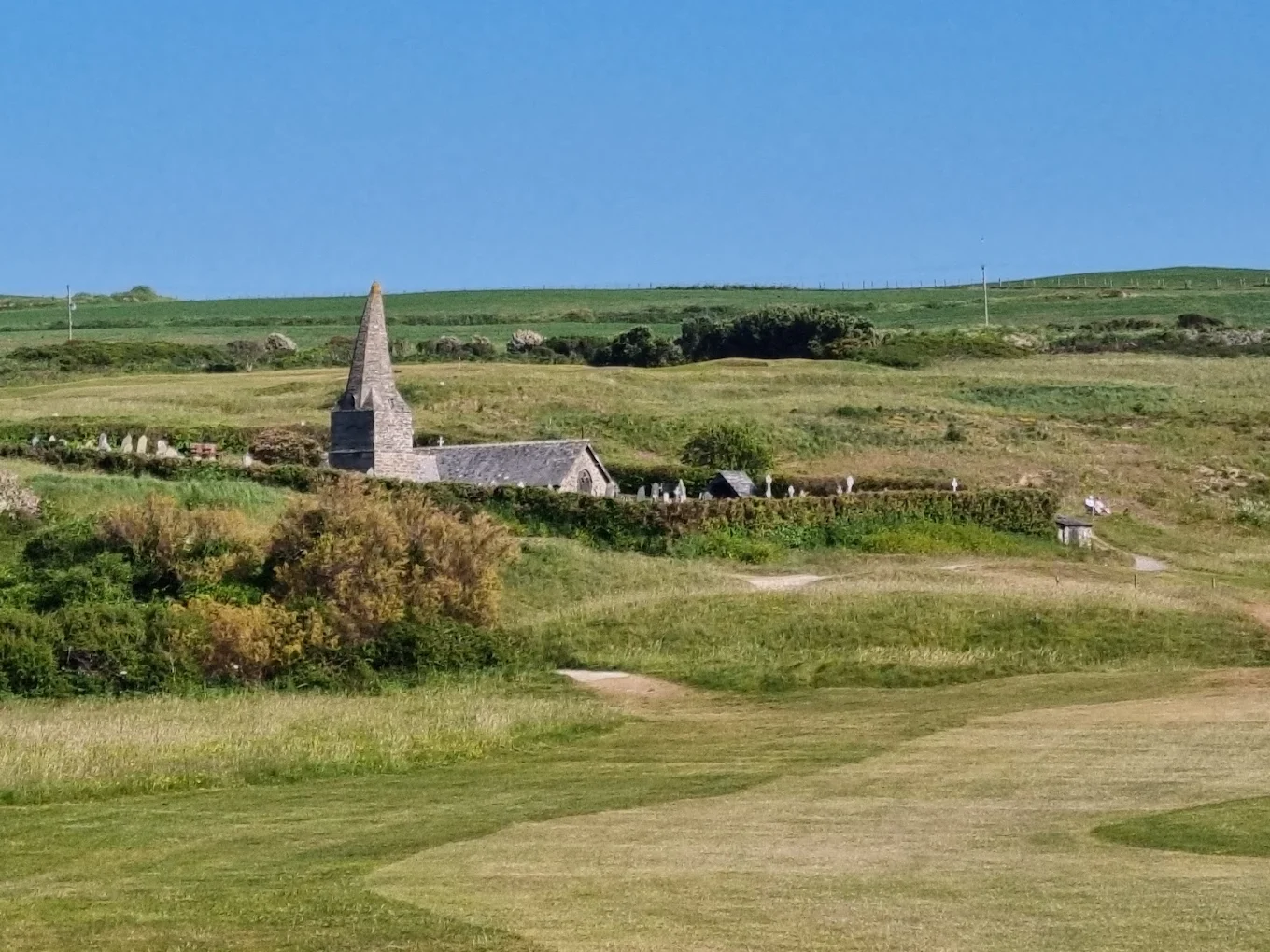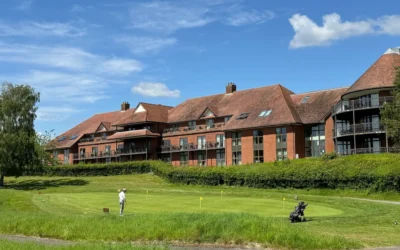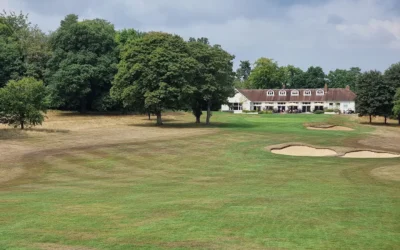St Enodoc Golf Club Church Course
St Enodoc Golf Club Church Course (Wadebridge, Cornwall, England)
Tucked along Cornwall’s rugged north coast, St Enodoc Golf Club Church Course is a links masterpiece that blends raw natural beauty with golfing heritage. Designed by five-time Open Champion James Braid, this course dances through towering sand dunes, offering sweeping views of the Camel Estuary and the Atlantic’s shimmering horizon. Its challenging layout, punctuated by the colossal Himalaya bunker and the historic 12th-century St Enodoc Church, has tested golfers since 1907.
From Sir John Betjeman’s poetic tribute in “Seaside Golf” to its hosting of elite amateur championships, St Enodoc is a pilgrimage for those seeking to conquer its fairways and soak in its timeless charm. Teeing off here feels like stepping into a living postcard, where every shot is framed by Cornwall’s wild splendor and the echoes of golfing legends.
Key Details
- Location: Rock, Wadebridge, Cornwall, England
- Length: 6,557 yards (blue tees)
- Par: 69
- Designers: James Braid (1907), with updates by Peter McEvoy (2004)
- Established: 1890 (club formed), 1907 (course designed)
- Notable Events:
- English Men’s Amateur Championship (1999, 2008)
- English Women’s Amateur Championship (2014, 2018)
- English County Finals (2005, 2025)
- English Ladies’ Close Championship (1937)
- West of England Championship (regular host)
History and Significance
Founding and Early Years
Golf at St Enodoc began in 1888, when undergraduates played around the 12th-century St Enodoc Church and Daymer Bay. In 1889, local gentlemen laid out initial holes at Rock, formalizing St Enodoc Golf Club in 1890 with about 20 members and a modest 5-shilling subscription. By 1907, James Braid was commissioned to craft an 18-hole course, leveraging the dramatic dunes and natural terrain to create a layout that remains a cornerstone of links golf. Early leases, like Dr. Theophilus Hoskin’s 1905 agreement for £30 annually, secured the land, setting the stage for the club’s growth.
Evolution and Redesigns
Braid’s vision evolved through subsequent visits, with significant updates in 1922 and 1937 that refined the course, adding holes like the current 8th, 11th, and 12th, and reshaping the 17th and 18th. In 2004, Peter McEvoy modernized the layout with new bunkering, additional tees, and a relocated 13th green, ensuring it could challenge contemporary players. The par-5 16th was extended to 560 yards in 2007, enhancing its strategic depth. These changes preserved Braid’s natural routing while adapting to modern equipment, maintaining St Enodoc’s reputation as a tough yet fair test.
Major Tournaments and Events
St Enodoc has hosted a roster of prestigious amateur events, cementing its status in British golf. The English Men’s Amateur Championship graced the course in 1999 and 2008, while the English Women’s Amateur Championship followed in 2014 and 2018. The English County Finals were held in 2005, with another scheduled for 2025, and the West of England Championship is a regular fixture. The 1937 English Ladies’ Close Championship, won by Wanda Morgan, marked an early milestone. These events highlight the course’s ability to challenge elite players while remaining accessible to visitors.
Cultural Significance and Modern Recognition
Ranked 74th in the world by Top 100 Golf Courses in 2022 and 36th in the UK & Ireland, St Enodoc is a global golfing gem. Sir John Betjeman’s “Seaside Golf” immortalized its beauty, ending with “splendour, splendour everywhere,” and his burial beside the 10th green adds cultural weight. The course’s quirky charm, from the Himalaya bunker to the church’s presence, draws golfers seeking a blend of history and challenge. Its welcoming visitor policy and proximity to Cornwall’s attractions make it a bucket-list destination.
Course Features
General Layout and Terrain
St Enodoc’s Church Course is a quintessential links layout, stretching 6,557 yards across Cornwall’s dune-laden coast. Its par-69 design belies its difficulty, with a course record of just 65, four under par. Firm, humpy fairways and unpredictable bounces demand creativity, while the routing ensures players face shifting winds from all directions. The course’s natural contours, with three holes rising or falling over 80 feet, create a rollercoaster-like experience that compares to Cruden Bay for its pace and joy.
Unique Features and Challenges
The course’s standout feature is the Himalaya bunker on the 6th, one of Europe’s largest, looming 90 yards from the green and forcing strategic decisions. Deep, revetted bunkers, blind shots, and contoured greens add complexity, with five bunkerless holes relying on natural hazards like burns and dunes. The par-3 15th, with its green behind a paved road, introduces quirky bounces, while the wind off the Atlantic can turn a wedge into a wood. The course’s short length is deceptive, as precision trumps power, making it a thinking golfer’s paradise.
Scenic Elements and Overall Experience
St Enodoc’s beauty is unrivaled, with vistas of Padstow, the Camel Estuary, and the Atlantic framing every hole. The 12th-century St Enodoc Church, partially buried by dunes until 1864, sits beside the 10th green, adding historical gravitas. The course’s dunescape, wild sea grass, and ever-changing light create a sensory feast. Playing here is an immersive journey, blending physical challenge with emotional resonance, where the landscape and legacy elevate every round.
Signature Holes
6th Hole – Par 4, 428 yards (Blue Tees)
The 6th hole is St Enodoc’s crown jewel, defined by the Himalaya bunker, a monstrous hazard 90 yards from the green that calls a “game-changer.” This dogleg-right par 4 demands a precise drive to avoid dunes, followed by an approach that must carry or skirt the bunker to reach a ¾ punchbowl green. The hole rewards bold play but punishes errors, with the bunker’s scale and the estuary views creating a thrilling test of nerve and skill.
10th Hole – Par 4, 457 yards (Blue Tees)
The 10th is a dramatic par 4, its narrow fairway flanked by a burn left and dunes right, culminating at a green beside the St Enodoc Church. With no bunkers, the hole relies on natural hazards, as described as “canyon-like.” The approach requires pinpoint accuracy, with the church’s ancient spire adding a spiritual backdrop. This hole, one of Braid’s originals, encapsulates the course’s blend of challenge and heritage.
16th Hole – Par 5, 560 yards (Blue Tees)
Extended in 2006, the 16th is a reachable par 5 that tempts aggressive play. The fairway zags right, descending 260 yards from the green, which sits atop a dune. Strategic bunkering and wind complicate the approach, but a well-executed shot can yield eagle or birdie. The hole’s elevated green and estuary views make it a memorable climax to the round, rewarding courage and precision.
Why Visit
Golfing Challenge and Appeal
St Enodoc’s Church Course is a stern test, with its 6,557 yards and par 69 demanding accuracy over distance. The course’s undulating fairways, deep bunkers, and wind exposure challenge even seasoned players, yet its visitor tees (6,108 yards) make it accessible. Notes, “The routing is wonderful,” ensuring varied play that keeps golfers engaged. Its handicap limit (21.4 for men, 22.7 for women) ensures a fair challenge for all.
Emotional and Historical Resonance
Walking St Enodoc’s fairways is a journey through time. The course’s connection to James Braid, its hosting of amateur championships, and the presence of the St Enodoc Church create a profound sense of history. Sir John Betjeman’s burial beside the 10th green and his poetic praise add emotional depth, making each round feel like a communion with golf’s soul. Golfers leave with memories of a course that tests both skill and spirit.
Quotes and Practical Benefits
“Lark song and sea sounds in the air, and splendour, splendour everywhere,” wrote Betjeman, capturing St Enodoc’s magic. The clubhouse’s dining, with local Cornish fare, and practice facilities enhance the visit, while the Holywell Course offers a gentler alternative for novices. Its location, just 30 minutes from Trevose Golf Club, makes it ideal for a Cornish golf tour, as suggested.
Facilities
Clubhouse and Dining
St Enodoc’s clubhouse is a welcoming retreat, featuring a bar, lounge, and dining areas with estuary views. Breakfast is served from 8:30 am, and a full menu, showcasing Cornish produce, is available from 11:30 am to 4:30 pm, per St Enodoc Golf Club. Two outdoor seating areas offer al fresco dining, while the dress code (smart casual, no beach attire) maintains a refined atmosphere. The pro shop stocks gear and rentals.
Practice Areas and Additional Services
While specific practice facilities aren’t detailed, clubs of St Enodoc’s caliber typically offer putting greens and chipping areas. Caddies are available with prior notice, and buggies (£40 for Church Course) require a medical certificate. The club’s golf reception provides personalized service, and the Holywell Course serves as a practice-friendly option for honing skills, ensuring visitors are well-prepared for the Church Course’s challenges.
Contact Details and Directions
- Address: St Enodoc Golf Club, Rock, Wadebridge, Cornwall, PL27 6LD, England
- Phone: +44 1208 863216
- Email: reservations@st-enodoc.co.uk
- Directions: Located in Rock, St Enodoc is a 4.5-hour drive from London via the M5 and A30 or 30 minutes from Bodmin Parkway station via the A389. From Newquay Airport, it’s a 40-minute drive.
- Public Transport: Bodmin Parkway, served by Great Western Railway, is the nearest station; taxis or car rentals are recommended for the final leg.
- Parking: Ample on-site parking is available.
- Map: View on Google Maps
Green Fees and Booking
Green fees for 2025 vary by season, with a non-refundable deposit required. Book online at St Enodoc Golf Club or call +44 1208 863216. Handicap limits (21.4 men, 22.7 ladies) apply, and smart golf attire is mandatory. Check-in is 30 minutes prior, with refunds only if the course closes.
|
Season |
Adult |
Junior |
|
Peak (May–Oct) |
£160 |
£80 |
|
Shoulder (Mar–Apr, Nov) |
£120 |
£60 |
|
Off Peak (Jan–Feb) |
£90 |
£45 |
Nearby Attractions
Cornwall’s north coast offers a wealth of attractions to complement a golfing trip to St Enodoc, blending coastal charm, history, and adventure.
|
Attraction |
Appeal |
Distance from Club |
|
Padstow |
Harbor town with dining and shops |
~2 miles (by ferry) |
|
St Enodoc Church |
12th-century historical site |
On course |
|
Daymer Bay Beach |
Sandy beach for relaxation |
~1 mile |
|
The Camel Trail |
Cycling and walking path |
~5 miles |
|
Rick Stein’s Cookery School |
Culinary classes by celebrity chef |
~2 miles (Padstow) |
|
Polzeath Beach |
Surfing and coastal activities |
~3 miles |
- Padstow: A vibrant town across the estuary, famous for Rick Stein’s restaurants and a bustling harbor, accessible via the Padstow-Rock ferry.
- St Enodoc Church: A historic gem on the course, once buried by dunes, offering a glimpse into Cornwall’s past.
- Daymer Bay Beach: A family-friendly beach with calm waters, ideal for swimming and picnics.
- The Camel Trail: A 17-mile trail for cycling or walking, linking Padstow to Bodmin through scenic countryside.
- Rick Stein’s Cookery School: Learn seafood cooking from a renowned chef, perfect for non-golfers.
- Polzeath Beach: A surfing hotspot with schools and rentals, offering adventure for all ages.
Frequently Asked Questions (FAQs)
How do I book a tee time at St Enodoc Golf Club?
Book online at St Enodoc Golf Club or contact the golf reception at +44 1208 863216 or reservations@st-enodoc.co.uk.
What are the green fees at St Enodoc Golf Club?
Fees range from £90 (off-peak) to £160 (peak) for adults, with juniors at half price. Check St Enodoc Golf Club for details.
Is the course suitable for beginners at St Enodoc Golf Club?
The Church Course is challenging, but the Holywell Course is ideal for beginners, with no handicap restrictions.
What is the best time to play at St Enodoc Golf Club?
May to October offers optimal weather, though March to April and November provide quieter rounds with good conditions.
What is the dress code St Enodoc Golf Club?
Smart golf attire is required on the course (no denim or beach wear); smart casual applies in the clubhouse, per St Enodoc Golf Club.
What facilities are available in St Enodoc Golf Club?
The clubhouse offers dining, a bar, lounge, and pro shop. Practice facilities likely include putting greens; caddies and buggies are available.
How do I get to St Enodoc Golf Club?
Drive 4.5 hours from London or 30 minutes from Bodmin Parkway. Taxis from the station are recommended due to limited public transport.
Are there other golf courses nearby at St Enodoc Golf Club?
Trevose Golf Club, 30 minutes away, offers another top-tier links experience, per GolfSouthWest.
What major tournaments has St Enodoc Golf Club hosted?
Events include the English Men’s Amateur (1999, 2008), Women’s Amateur (2014, 2018), and English County Finals (2005, 2025).
Why is St Enodoc Golf Club famous?
Its Braid design, Himalaya bunker, church setting, and Betjeman’s poetry make it a celebrated links course.
Is St Enodoc Golf Club accommodation on-site?
No, but nearby options include St Enodoc Hotel and The Point at Polzeath, per GolfSouthWest.
Are St Enodoc Golf Clubmembership options?
Membership is available; contact the club at +44 1208 863216 for details.
What is the weather like in St Enodoc Golf Club?
Cornwall’s climate is temperate but changeable; pack layers and waterproofs, especially for coastal winds.
What is the history of St Enodoc Golf Club?
Established in 1890, designed by Braid in 1907, it has hosted elite amateur events and remains a top-ranked links course.
What are the unique features of St Enodoc Golf Club?
The Himalaya bunker, St Enodoc Church, and estuary views define its distinctive character.
East Sussex National Golf Club West Course
East Sussex National Golf Club West Course (Little Horsted, East Sussex, United Kingdom) Imagine standing on an elevated tee, gazing across a lush valley framed by ancient oak trees, their branches swaying gently in the Sussex breeze. Below, a fairway winds alongside...
Wildernesse Golf Club
Wildernesse Golf Club (Sevenoaks, Kent, England) Tucked away in the verdant landscapes of Kent, often dubbed the "Garden of England," Wildernesse Golf Club is a hidden gem that has enchanted golfers for over a century. Since its founding in 1890, this private members’...
Moor Park Golf Club (High Course)
Moor Park Golf Club (High Course) (Rickmansworth, Hertfordshire, England) Picture yourself standing on the tee, gazing across a lush parkland framed by ancient trees, with the elegant silhouette of a 17th-century mansion in the distance. Moor Park (High) Golf Course...
Frilford Heath Golf Club (Red Course)
Frilford Heath Golf Club (Red Course) (Oxfordshire, England) Nestled in the heart of Oxfordshire’s rolling countryside, Frilford Heath’s Red Course offers a quintessential heathland golfing experience. Designed by the legendary JH Taylor, a five-time Open Champion,...
Royal Cromer Golf Club
Royal Cromer Golf Club (Cromer, Norfolk, England) Perched dramatically on the clifftop of the North Norfolk coast, Royal Cromer Golf Club offers golfers a unique blend of history, challenge, and breathtaking scenery. As you stand on the first tee, with the North Sea...





